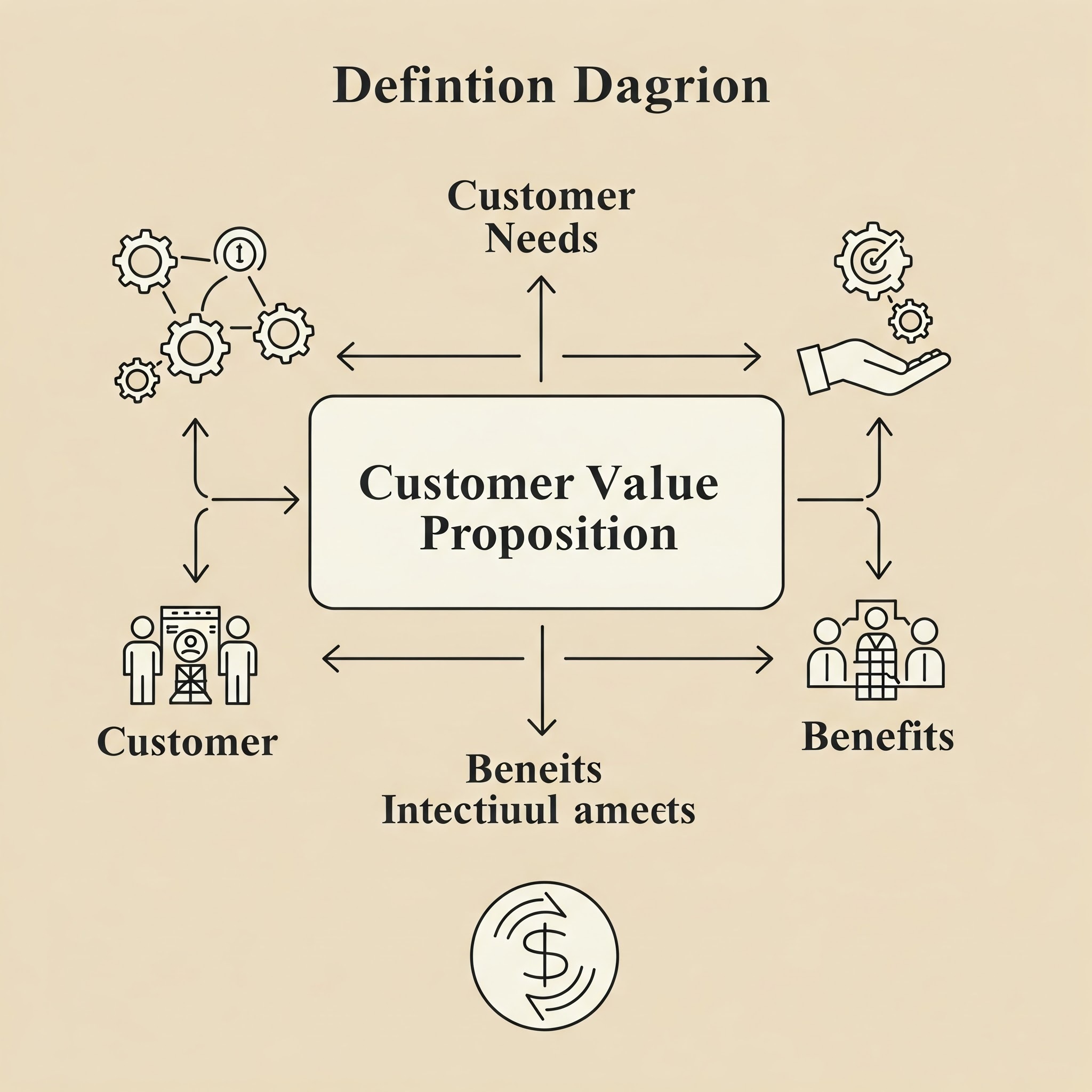Why Value Selling Drives Successful Sales
In today’s competitive B2B landscape, businesses can no longer rely solely on product features to win customers. Value selling shifts the focus from what a product does to how it solves customer problems, improves efficiency, and delivers measurable business impact. A well-crafted Customer Value Proposition (CVP) Strategy effectively ensures businesses communicate their unique value, setting them apart from competitors and driving long-term customer relationships.
What You’ll Learn in This Article
This guide explores the fundamentals of Customer Value Proposition Strategy, outlines six key steps to crafting a compelling B2B CVP, and provides actionable insights on implementing, measuring, and refining your value proposition. It also includes a real-world example of a transportation optimization software company, showcasing how a CVP can be positioned to drive measurable business success.
What is a customer value proposition strategy?
A Customer Value Proposition (CVP) Strategy is a structured approach to defining and communicating the unique benefits that a product or service provides to its target customers. It differentiates a business from competitors by focusing on its customers’ needs, desires, and pain points, ensuring that the offered value aligns with what they care most.
6 Steps to a B2B Customer Value Proposition
Step 1: Understand Your Target Customer
A strong B2B value proposition starts with a deep understanding of your target customer. Knowing their expectations, pain points, and decision-making drivers is crucial. This knowledge empowers you to tailor your value proposition to each buyer’s concerns, ensuring it is compelling and relevant.
Since different stakeholders have varying priorities, your value proposition should be tailored accordingly. For example, an Operations Manager may focus on efficiency and workflow improvements, while a CFO will prioritize cost savings and revenue impact. Aligning your messaging with each buyer’s concerns ensures a more compelling and relevant value proposition.
Step 2: Clearly Define the Problem, then Be the Problem Solver
As the saying goes, “Find the pain, ease the pain.” Before offering a solution, thoroughly understand the challenges your target customers face.
You build trust and establish long-term relationships by positioning your business as a problem solver rather than just a seller. This approach ensures that your value proposition resonates with the customer’s needs, making your offering more compelling and relevant.
Step 3: Position Your Solution Through the Customer’s Eyes
B2B customers often face similar challenges—digital transformation, competitive differentiation, shrinking margins, and ROI concerns. To create a compelling value proposition, you must acknowledge these issues and demonstrate how your product or service solves them. By deeply understanding your target audience (Step 1), you can tailor your messaging to address their pain points. A customer-centric approach ensures your solution is considered essential, relevant, and impactful.
By deeply understanding your target audience (Step 1), you can tailor your messaging to address their pain points. A customer-centric approach ensures your solution is considered essential, relevant, and impactful.
Step 4: Provide Proof
B2B buyers prioritize risk mitigation. To build trust and reduce perceived risk, back your value proposition with concrete proof that your solution delivers results.
As customers move through the buyer’s journey, they require increasing levels of validation. Provide both qualitative and quantitative proof:
- Qualitative: Showcase how your product improves workflow, enhances efficiency, or accelerates processes.
- Quantitative: Use complex data, such as cost savings, increased productivity, or reduced labor expenses, to demonstrate measurable impact.
Case studies, testimonials, and success metrics from similar businesses reinforce credibility and make your value proposition more compelling. Showing that others have achieved real results with your solution helps ease concerns and drives confidence in the buying decision.
Step 5: Analyze Competitor Offerings
You must understand how your solution compares to competitors to craft a compelling value proposition. Ask yourself: Why should a customer choose us over someone else?
Research your competitors’ benefits, features, and messaging. Highlight your unique strengths. Clearly articulate what sets you apart, whether it’s superior functionality, better pricing, enhanced customer support, or proven results.
Step 6: Align Value Marketing and Value Selling
A strong value proposition is only practical if marketing and sales consistently communicate it. Yet, many organizations struggle with alignment between these teams.
According to the Aberdeen Group, companies that align sales and marketing achieve:
- 38% higher win rates
- 32% higher revenue
- 36% greater customer retention
To maximize impact, ensure that:
- Sales teams have the right marketing materials to reinforce the value proposition.
- Marketing and sales collaborate on defining ideal customer profiles and messaging strategies.
- Customer value remains central at every stage of the buyer’s journey.
By bridging the gap between marketing and sales, your organization can deliver a unified, compelling value proposition that resonates with B2B buyers and drives better results. This alignment ensures that customer value remains central at every stage of the buyer’s journey, instilling confidence in your audience.
Setting Up Your Value Proposition Strategy
To ensure your Customer Value Proposition (CVP) remains effective and drives business success, follow these key steps:
1. Develop a Clear Implementation Plan
- Set SMART goals (Specific, Measurable, Achievable, Relevant, Time-bound) aligned with your CVP.
- To ensure smooth execution, assign responsibilities to relevant teams, including marketing, customer service, and product development.
2. Monitor Customer Feedback Continuously
- Continuous monitoring of customer feedback is essential to understand how well your CVP resonates. By gathering insights from surveys, customer reviews, focus groups, and support interactions, you can proactively refine your value proposition to better meet customer needs.
- Use feedback to refine messaging, improve offerings, and enhance customer satisfaction.
3. Align Cross-Functional Teams
- Ensure marketing, sales, product development, and customer support align with the CVP.
- A unified approach helps create consistent messaging and a seamless customer experience.
4. Measure Performance Regularly
- Define and track Key Performance Indicators (KPIs) such as conversion rates, customer retention, and revenue growth to evaluate CVP effectiveness.
- Use data-driven insights to refine and improve your approach.
5. Adapt to Market Changes
- Stay proactive by monitoring industry trends, competitor moves, and customer expectations to keep your CVP relevant.
- Adjust your strategy to leverage new opportunities or respond to emerging threats.
6. Continuously Optimize Your Offerings
- Innovate and evolve your products or services to maintain a competitive edge.
- Focus on delivering greater convenience, improved experiences, and enhanced customer value over time.
Example of a Customer Value Proposition Strategy
Company “OptiTrans” – AI-Powered Transportation Optimization Software
1. Understanding the Target Customer
OptiTrans serves logistics managers, supply chain directors, and transportation coordinators in retail, manufacturing, and third-party logistics industries. Their primary pain points include:
- High fuel costs and inefficient routing.
- Delivery delays due to poor logistics planning.
- Lack of real-time visibility into fleet operations.
2. Defining the Problem
Many businesses struggle with inefficient transportation management, which leads to rising operational costs, missed deliveries, and frustrated customers. Traditional routing methods are outdated and reactive and fail to optimize for fuel efficiency, traffic conditions, and vehicle capacity.
3. Positioning the Solution Through the Customer’s Eyes
OptiTrans provides an AI-driven transportation optimization platform that integrates with existing fleet management systems to:
- Optimize delivery routes in real-time, reducing fuel costs and transit time.
- Enhance fleet visibility with live tracking and predictive analytics.
- Improve load efficiency, reducing empty miles and maximizing capacity utilization.
4. Providing Proof
OptiTrans showcases measurable results from existing customers:
- 20% reduction in fuel costs through intelligent route optimization.
- 15% faster delivery times, improving customer satisfaction.
- 30% decrease in empty miles, leading to lower operational costs.
5. Checking Competitor Offerings
Competitors offer static route planning and GPS tracking, but OptiTrans differentiates itself with:
- AI-powered dynamic route adjustments based on traffic, weather, and fuel prices.
- Predictive maintenance insights to prevent vehicle downtime.
- Seamless integration with ERP and fleet management systems for end-to-end visibility.
6. Aligning Value Marketing and Sales
OptiTrans ensures that marketing and sales work together to present a unified value proposition:
- Marketing educates customers with case studies, whitepapers, and ROI calculators.
- Sales teams use data-driven insights to demonstrate cost savings and operational improvements tailored to each client’s needs.
Final Value Proposition Statement
“OptiTrans empowers businesses to reduce transportation costs, optimize delivery efficiency, and enhance real-time fleet visibility using AI-driven logistics intelligence—helping companies increase profitability while ensuring on-time deliveries.”
Final Thoughts
A strong Customer Value Proposition Strategy is more than just a marketing statement—it’s a strategic foundation that drives customer engagement, competitive differentiation, and long-term business success. By clearly defining your customers’ challenges, aligning your solution with their needs, and continuously optimizing your approach, you ensure your business delivers real, measurable value that resonates in the market.
But building and maintaining a high-impact CVP isn’t always easy. That’s where ValueCore comes in.
At ValueCore, we specialize in helping businesses develop, refine, and implement compelling value propositions that drive growth and customer loyalty. Whether you need help identifying your unique differentiators, aligning sales and marketing, or leveraging data-driven proof points, we provide the expertise and tools to make your value proposition a decisive competitive advantage.
Partner with ValueCore today to craft a customer-centric, results-driven CVP that sets your business apart and fuels your success. Let’s turn your value into your biggest asset.




